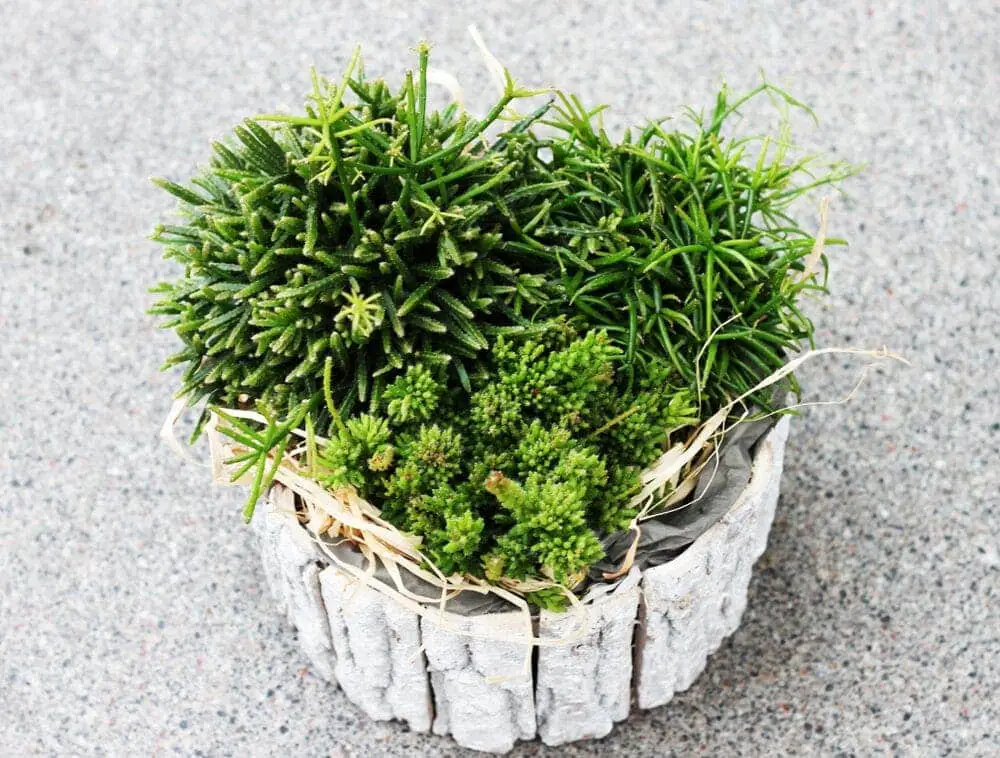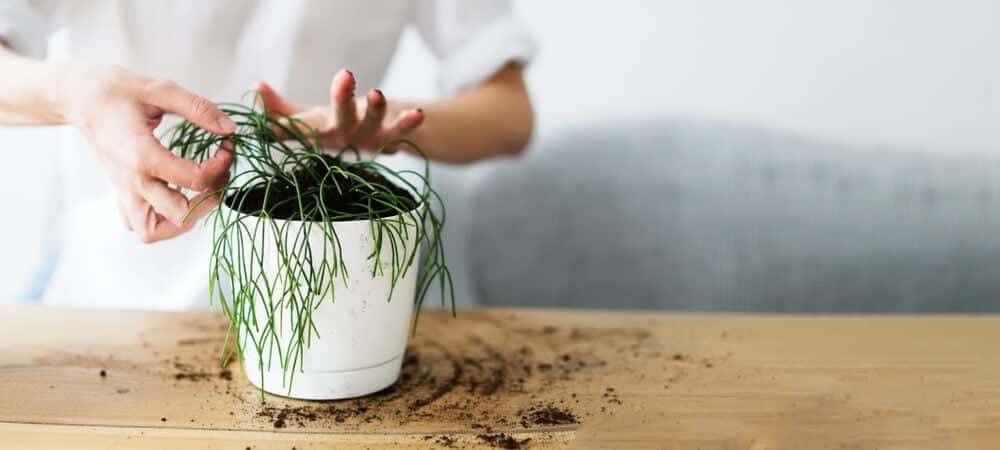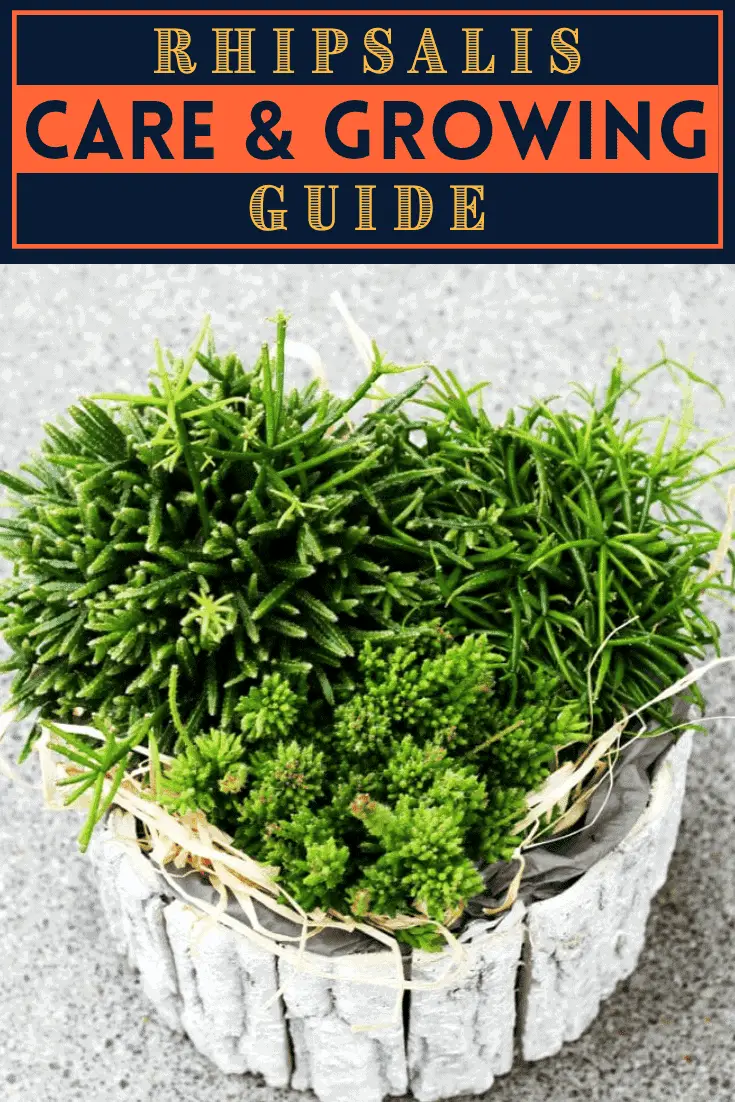This cactus family has interesting and unusual growth patterns on their leaves.
Although it’s not a holly with red berries, they are also known as the mistletoe cactus, for those desert dwellers who still want a Christmas kiss! It is part of a cactus family that lives all over Central and South America. This cactus family has over 35 different plants that wow your neighbors and impress your friends.
Rhipsalis Care & Growing Guide
1. Light Requirement
Don’t place this plant in front of full direct sunlight. It prefers to be in indirect light that is very bright. It can also tolerate a little bit of morning or evening light, but by noon it should be protected and under the shade.
If the light is coming from one side of the room, the Rhipsalis must be turned so that all the leaves are evenly exposed to light.
If you’re unable to provide enough light for this plant, don’t fret. This plant is very hardy and can still grow on minimal amounts of light for quite a while. It even does well in artificial lighting. Just take it out once in a while and put it in bright light for a bit, then it can go back into its minimal light.
2. Water
Every time this plant is to be watered, always check the soil to see how damp it is. This is a cactus, so it will not need a lot of water or a regular watering schedule.
Because it is a cactus, it does not need much water in the first place. Only water is about once a week or whenever the soil is dry to the touch. Over-watering can have negative effects on its health.
One way to tell if the Rhipsalis needs to be watered is in its leaves and stems look droopy and wilted.
Although the Rhipsalis is part of the cactus family, it is not drought tolerant. However, it is hardy, and it can come back from underwatering for a very long time.
3. Climate and temperature
The Rhipsalis does well in hardiness zones 9 and 10. It does best when temperatures are at least 60 degrees or above.
Humidity is important to this plant, and any room it isn’t should be made human. It can be placed by a humidifier to give it the humidity that it needs. If the furniture in the room can stand it, try to aim for 50% humidity.
The best temperature for this plant is from 60 to 75 degrees.

4. Soil
The soil for the Rhipsalis should be very loose and well-draining. It is also good if it is well aerated because aerated soil allows oxygen to reach the roots.
When placing this plant in a pot or container, use a high-quality cactus potting soil mix.
If fertilizer is going to be added to the potting soil that is in, only fertilize the Rhipsalis during its growing season. It does not need to be fertilized in the winter when it is dormant.
5. Repotting
Plants in the Rhipsalis family should be repotted every few years, about 3 to 4 years.
When repotting occurs, make sure the soil it is being transferred into is very loose and aerated. Add a bit of sand to improve drainage.
Only repot this plant when its flowers have fallen off. This occurs in the late spring. Do not try to repot it if its flowers are in full bloom. Doing so jeopardizes the health of the plant.
If your Rhipsalis is having trouble growing, it could be because it has never been repot it before.
6. Speed of Growth
Even in the best of conditions, the Rhipsalis plant is not known to be a fast-growing family of cactuses. It has slow to moderate growth during its growing season. After, it will go dormant.
7. Height and Spread
This plant can grow up to 6 feet tall and 3 to 4 ft wide if it is pruned to do so. Controlling the height of this plan is easy if you’re diligent about it
8. Trimming
Because of its slow growth, you may not want to trim this plant too often. Always trim off dead or decayed stems and roots.
To trim the plant, cut as much stem off as possible but don’t remove the node. The node help created extra leaves.

Is the Rhipsalis poisonous?
No, plants in the Rhipsalis family are not poisonous to either humans or animals. But that does not mean that they can be eaten.
Can Rhipsalis Grow in Water?
No members of the Rhipsalis family can grow in water. They do not like to be waterlogged and require a minimal amount of water on a weekly basis.
Similar post: Strawflower Care & Growing Guide
Does the Rhipsalis have flowers, and how do I get them to bloom?
Yes, the Rhipsalis genus is known for its pretty flowers in most of its species of plants. During the blooming season, the flowers bloom during the day and then close their petals together at night.
To help the flowers bloom, make sure it is well watered and has plenty of indirect light.
Common Rhipsalis Pests and diseases
Root rot occurs when soil is damp, but temperatures are warm. It affects the roots and slowly turns the stems and leaves brown as it works its way up. To fight against this, you will have to repot the plant with brand new soil and apply a fungicide to the roots. Cut off any disease parts of the plant
Mealybugs are ugly furry white bugs that can quickly kill plants if there is an infestation of them. They kill plants by sucking out their nutrients and sap from the stems. To get rid of them, watch them off with a hose or in the sink and then apply insecticide to the entire plant.
Also read:
Conclusion
- The Rhipsalis is the only Cactus plant that is found outside of the North and South America. Most cactus grow in the Americas. It is also found in tropical areas of Africa and Sri Lanka.
- This plant can grow on top of other plants or even on dead plants.
- Since this plant is from South or Central America, make sure the air around this plant is humid.
- Only fertilize the Rhipsalis during its growing season and never in the winter.
- When this plant needs to be repotted, never do it during its bloom. Always repot it after the flowers they have wilted. This is usually in late spring.

Victoria is the owner and main author of hobby plants. She loves spending her free time in her garden planting and taking care of her plants. Victoria hopes you enjoy the content here!
![Queen Of The Night Flower [Complete Plant Care Guide] Queen Of The Night Flower [Complete Plant Care Guide]](https://www.hobbyplants.com/wp-content/uploads/2022/07/queen-of-the-night-flower-300x158.jpg)
![Mother Of Thousands Plant [Complete Plant Care Guide] Mother Of Thousands Plant [Complete Plant Care Guide]](https://www.hobbyplants.com/wp-content/uploads/2022/07/mother-of-thousands-plant-300x158.jpg)
![How Often Should You Water Pothos? [Complete Care Guide] How Often Should You Water Pothos? [Complete Care Guide]](https://www.hobbyplants.com/wp-content/uploads/2022/07/how-often-to-water-pothos-300x158.jpg)
![Can Snake Plants Live Outside? [COMPLETE CARE GUIDE] Can Snake Plants Live Outside? [COMPLETE CARE GUIDE]](https://www.hobbyplants.com/wp-content/uploads/2022/08/can-snake-plants-live-outside-300x158.jpg)
![Majesty Palm Plant Care: [Complete Beginner's Guide] Majesty Palm Plant Care: [Complete Beginner's Guide]](https://www.hobbyplants.com/wp-content/uploads/2022/08/majesty-palm-care-300x158.jpg)
![Exotic Angel Plant Care: [Complete Beginner's Guide] Exotic Angel Plant Care: [Complete Beginner's Guide]](https://www.hobbyplants.com/wp-content/uploads/2022/08/exotic-angel-plant-care-300x158.jpg)
![Do Coleus Like Sun Or Shade: [Complete Care Guide] Do Coleus Like Sun Or Shade: [Complete Care Guide]](https://www.hobbyplants.com/wp-content/uploads/2022/08/coleus-sun-or-shade-300x158.jpg)
![Snow White Waffle Plant: [Complete Care Guide] Snow White Waffle Plant: [Complete Care Guide]](https://www.hobbyplants.com/wp-content/uploads/2022/08/snow-white-waffle-plant-300x158.jpg)
![Waffle Plant Care: [Complete Beginner's Guide] Waffle Plant Care: [Complete Beginner's Guide]](https://www.hobbyplants.com/wp-content/uploads/2022/08/waffle-plant-300x158.jpg)
![Bird Of Paradise Plant Care: [Complete Beginner's Guide] Bird Of Paradise Plant Care: [Complete Beginner's Guide]](https://www.hobbyplants.com/wp-content/uploads/2022/08/bird-of-paradise-plant-300x158.jpg)
![Purple Passion Plant Care: [Complete Beginner's Guide] Purple Passion Plant Care: [Complete Beginner's Guide]](https://www.hobbyplants.com/wp-content/uploads/2022/08/purple-passion-plant-care-300x158.jpg)
![China Doll Plant Care: [Complete Beginner's Guide] China Doll Plant Care: [Complete Beginner's Guide]](https://www.hobbyplants.com/wp-content/uploads/2022/09/china-doll-plant-care-300x158.jpg)